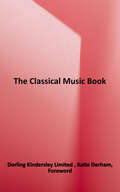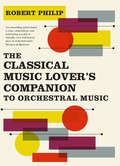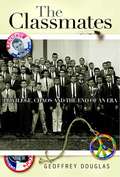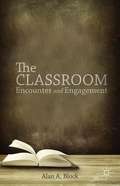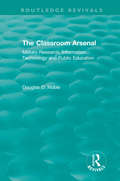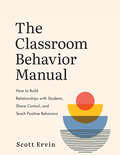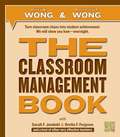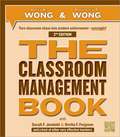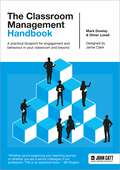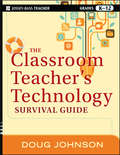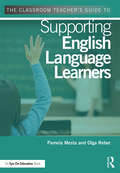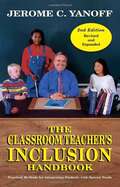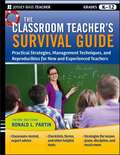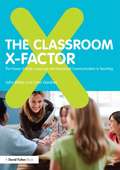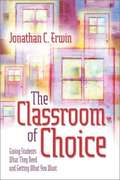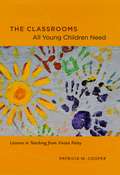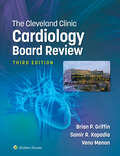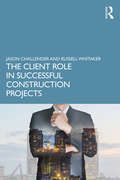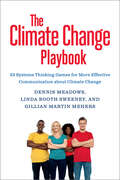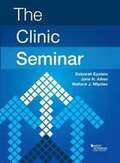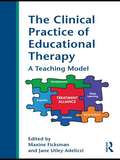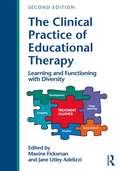- Table View
- List View
The Classical Music Book: Big Ideas Simply Explained (DK Big Ideas Ser.)
by Dorling Kindersley LimitedLearn about the world’s greatest classical compositions and musical traditions in The Classical Music Book. Part of the fascinating Big Ideas series, this book tackles tricky topics and themes in a simple and easy-to-follow format. Learn about Classic Music in this overview guide to the subject, great for novices looking to find out more and experts wishing to refresh their knowledge alike! The Classical Music Book brings a fresh and vibrant take on the topic through eye-catching graphics and diagrams to immerse yourself in. This captivating book will broaden your understanding of Classical Music, with: - More than 90 pieces of world-famous music - Packed with facts, charts, timelines and graphs to help explain core concepts - A visual approach to big subjects with striking illustrations and graphics throughout - Easy to follow text makes topics accessible for people at any level of understanding The Classical Music Book is a captivating introduction to music theory, crucial composers and the impact of seminal pieces, aimed at adults with an interest in the subject and students wanting to gain more of an overview. Here you’ll discover more than 90 works by famous composers from the early period to the modern day, through exciting text and bold graphics. Your Classical Music Questions, Simply Explained From Mozart to Mendelssohn, this fresh new guide goes beyond your typical music books, offering a comprehensive overview to classical music history and biography. If you thought it was difficult to learn about music theory, The Classical Music Book presents key information in an easy to follow layout. Explore the main ideas underpinning the world’s greatest compositions and musical traditions, and define their importance to the musical canon and into their wider social, cultural, and historical context. The Big Ideas Series With millions of copies sold worldwide, The Classical Music Book is part of the award-winning Big Ideas series from DK. The series uses striking graphics along with engaging writing, making big topics easy to understand.
The Classical Music Lover's Companion to Orchestral Music
by Robert PhilipAn invaluable guide for lovers of classical music designed to enhance their enjoyment of the core orchestral repertoire from 1700 to 1950 Robert Philip, scholar, broadcaster, and musician, has compiled an essential handbook for lovers of classical music, designed to enhance their listening experience to the full. Covering four hundred works by sixty-eight composers from Corelli to Shostakovich, this engaging companion explores and unpacks the most frequently performed works, including symphonies, concertos, overtures, suites, and ballet scores. It offers intriguing details about each piece while avoiding technical terminology that might frustrate the non-specialist reader. Philip identifies key features in each work, as well as subtleties and surprises that await the attentive listener, and he includes enough background and biographical information to illuminate the composer’s intentions. Organized alphabetically from Bach to Webern, this compendium will be indispensable for classical music enthusiasts, whether in the concert hall or enjoying recordings at home.
The Classmates: Privilege, Chaos, and the End of an Era
by Geoffrey DouglasFifty years ago, in the fall of 1957, two thirteen-year-old boys were enrolled at an elite, boys-only New England boarding school. One of them, descended from wealth and eminence, would go on to Yale, then to a career as a navy officer and Vietnam war hero, and finally to the U.S. Senate, from where he would fall just short of the White House. The other was a scholarship student, a misfit giant of a boy from a Pennsylvania farm town who would suffer shameful debasements at the hands of his classmates, then go on to a solitary and largely anonymous life as a salesman of encyclopedias and trailer parts--before dying, alone, twelve months after his classmate's narrow loss on Election Day 2004. It is around these two figures, John Kerry and a boy known here only as Arthur, the bookends of a class of one hundred boys, that Geoffrey Douglas--himself a member of that boarding-school class--builds this remarkable memoir. His portrait of their lives and the lives of five others in that class--two more Vietnam veterans with vastly divergent stories, a federal judge, a gay New York artist who struggled for years to find his place in the world, and Douglas himself--offers a memorable look back to a generation caught between the expectations of their fathers and the sometimes terrifying pulls of a society driven by war, defiance, and self-doubt. The class of 1962 was not so different from any other, with its share of swaggerers and shining stars, outcasts and scholarship students. Its distinction was in its timing: at the precise threshold of the cultural and political upheavals of the late 1960s. The world these boys had been trained to enter and to lead, a world very similar to their fathers', would be exploded and recast almost at the moment of their entrance--forcing choices whose consequences were sometimes lifelong. Douglas's chronicle of those times and choices is both a capsule history of an era and a literary tour de force.
The Classroom
by Alan A. BlockWhat goes on in a classroom? can mean "Are teachers imparting knowledge that will raise test scores?" or it can mean much more. In this series of essays, Block addresses the nature of the classroom as a place for encounter and engagements: with curriculum materials and books, between teachers and students, and with the self.
The Classroom Arsenal: Military Research, Information Technology and Public Education (Routledge Revivals)
by Douglas D. NobleA quarter of a century after its initial publication, The Classroom Arsenal remains pivotal in understanding and challenging the relentless promotion of technology to reform education. This seemingly benign education technology juggernaut carries forward the momentum of military agendas in man-machine systems detailed in the book. Promoters continue to flood schools with technology and its (still unfulfilled) promise of cutting edge, "personalized learning." Meanwhile, they continue as well their insatiable pursuit of federal funding, educational legitimacy, corporate profits, and access to student subjects and their accumulated learning data for product development. Less understood, though, is a companion enterprise, there from the start, to replace teaching and learning in traditional classrooms by efficient automated systems that manage and monitor human cognition and learning for high-performance systems, from weapons systems to high tech corporations. As education is moved imperceptibly away from its traditional humanistic aims and from the classroom itself, the goal of this human engineering project, the depersonalized accumulation of cognitive components for a 21st century militarized economy, best befits the book’s original title: "The Human Arsenal." This ongoing military/corporate-sponsored enterprise continues to impact education today, largely unnoticed. One example is the federally-funded Advanced Distributed Learning Initiative (ADL), which has been a major force behind the implementation of electronic learning systems, now used in all Defense Department and federal employee training. With the Defense Advanced Research Project Agency (ARPA) ADL is developing structures to capture students’ soft skills, and the Army Research Laboratory is developing "intelligent tutoring systems" to enable "instructional management of affect, engagement, and grit (perseverance)." ADL through the Department of Defense has developed Experience API, a learning technology that can monitor all student online and offline interactions and archive these in date lockers or learning record stores. ADL has already impacted thousands of school districts through nonprofits such as IMS Global and Future Ready Schools, part of an industry massively subsidized by high tech corporations and valued at $255 billion annually. A $90 million Advanced Research Projects Agency for Education (ARPA-ED), modeled after the military’s ARPA, has been proposed to fund "dramatic breakthroughs in learning and teaching." These include "digital tutors as effective as personal tutors" and, with the Navy’s Full Spectrum Learning project, "data collection tools for personalized education modeled after corporate data analysis that identifies consumer patterns and preferences." ADL is just one example of how the military/corporate ed tech enterprise is changing public education by hollowing it out into something that can be digitized, data-driven, automated, and monitored. Its promoters envision education as children interacting with online learning systems where, based on past performance, algorithms will serve up what each student needs to know next. Through this digital curriculum, students create virtual educational identities at very young ages and learning devices are watching students as much as students are watching them. Such is the education landscape presaged by The Classroom Arsenal a quarter century ago, whose origins and trajectories need to be deeply understood now more than ever.
The Classroom Behavior Manual: How to Build Relationships with Students, Share Control, and Teach Positive Behaviors
by Scott ErvinPositive student behaviors are desired outcomes, but this manual concentrates on inputs. How do you respond to difficult behavior in the moment when you know that punitive, compliance-based behavior management is so often ineffectual? What's the best way to prevent students from acting out in the first place? The path to success requires behavioral leadership, in which teachers strategically model and affirm the behaviors they want to see in students.
The Classroom Management Book
by Harry K. Wong Rosemary T. Wong Sarah F. Jondahl Oretha F. FergusonThe number one problem in classrooms is the lack of classroom management, not discipline. This is a solutions book that turns classroom chaos into student achievement. It walks a teacher through organizing and structuring a classroom to create a safe and positive environment for student learning and achievement to take place. The book includes step-by-step teaching of 50 procedures that can be applied, changed, adapted, and incorporated into any classroom management plan and 40 QR (Quick Response) Codes that provide additional resources. All ideas are easy to implement at no cost. The concepts shared are suitable for all grades, all subjects, and all teachers. While all of the work and preparation behind a well-managed classroom are rarely observed, the dividends are evident in a classroom that is less stressful for all and one that hums with learning. This book is a companion book to The First Days of School and provides an in-depth look at classroom management.
The Classroom Management Book
by Harry K. Wong; Rosemary T. WongNow in its second edition, this is a solutions book that shows how to organize and structure a classroom to create a safe and positive environment for student learning and achievement to take place. It offers 50 procedures that can be applied, changed, adapted, and incorporated into any classroom management plan. Each procedure is presented with a consistent format that breaks it down and tells how to teach it and what the outcome of teaching it will be. While all of the work and preparation behind a well-managed classroom are rarely observed, the dividends are evident in a classroom that is less stressful for all and one that hums with learning.
The Classroom Management Handbook: A practical blueprint for engagement and behaviour in your classroom and beyond
by Oliver Lovell Dr. Mark DowleyPerhaps the biggest factor influencing teacher wellbeing and student learning is whether students are calm, focussed, and attentive in the classroom. Despite this, most teachers feel that their teacher training allocated far too little time to the fundamental principles and practical strategies that form the foundation of effective classroom management. In this book, Mark Dowley and Ollie Lovell address this shortfall by revealing 10 principles and 18 routines that will set you up for classroom management success. The Classroom Management Handbook, is the most concise, scaffolded, and unapologetically practical guide to classroom management available.
The Classroom Management Handbook: A practical blueprint for engagement and behaviour in your classroom and beyond
by Oliver Lovell Dr. Mark DowleyPerhaps the biggest factor influencing teacher wellbeing and student learning is whether students are calm, focussed, and attentive in the classroom. Despite this, most teachers feel that their teacher training allocated far too little time to the fundamental principles and practical strategies that form the foundation of effective classroom management. In this book, Mark Dowley and Ollie Lovell address this shortfall by revealing 10 principles and 18 routines that will set you up for classroom management success. The Classroom Management Handbook, is the most concise, scaffolded, and unapologetically practical guide to classroom management available.
The Classroom Teacher'S Technology Survival Guide
by Doug JohnsonA comprehensive guide for integrating educational technology in the K-12 classroom This is a must-have resource for all K-12 teachers and administrators who want to really make the best use of available technologies. Written by Doug Johnson, an expert in educational technology, The Classroom Teacher's Technology Survival Guide is replete with practical tips teachers can easily use to engage their students and make their classrooms places where both students and teachers will enjoy learning. Covers the most up-to-date technologies and how they can best be used in the classroom Includes advice on upgrading time-tested educational strategies using technology Talks about managing "disruptive technologies" in the classroom Includes a wealth of illustrative examples, helpful suggestions, and practical tips This timely book provides a commonsense approach to choosing and using educational technology to enhance learning.
The Classroom Teacher's Guide to Supporting English Language Learners
by Pamela Mesta Olga ReberThis book answers your key questions about educating English Language Learners (ELLs) and offers detailed guidance and concrete applications for your classroom. Designed as a one-stop-shop for classroom teachers of all grade levels and content areas, this book is chock full of essential information, delivered in a practical, concise format. In each chapter, you will find checklists, instructional strategies, tables, tools and ideas for next steps. The resources and examples provided are easy to implement and can be used the next day in your teaching. Topics addressed include: Getting to know your ELLs Considering how culture, language and academic background impact learning Bridging the home/school connection Pairing content and language objectives Gauging learner progress Collaborating with ELL staff Much more!
The Classroom Teacher's Inclusion Handbook: Practical Methods for Integrating Students With Special Needs
by Jerome C. YanoffFourteen types of special-needs students are discussed in this handbook on meeting the needs of a diverse student population within a mainstream classroom. Ranging from students with behavior disorders, ADHD, and mental retardation to the blind, terminally ill, and gifted and talented, each profile includes a clear definition, characteristic behaviors, and suggestions for working with that student's specific strengths and weaknesses. A section devoted to inclusion strategies helps educators set goals for special needs students, define the roles of other students in the classroom, and work with the administration if mainstream placement is unsuccessful.
The Classroom Teacher's Survival Guide
by Ronald L. PartinAn updated edition of the best-selling book for teacher success in the classroomDesigned for new and experienced teachers alike, this thoroughly revised and updated edition offers a value-packed, practical source of ready-to-use tips and strategies for meeting the challenges teachers face everyday while organizing and managing a classroom. The third edition includes entirely new sections on teaching English language learners, inquiry-based learning, building positive teacher-student relationships, wrapping up the school year, and much more. The book also features many new forms, pre-written letters, checklists, and reproducibles, along with bonus forms and reproducibles that are available for free download from the web.Includes tools and techniques proven to help teachers succeed in the classroomContains new sections on teaching English language learners, teacher-student relationships, inquiry-based learning, and moreMany handy reproducible forms, handouts, and checklistsIncludes access to free downloadable bonus material on the web, including pre-written letters, reproducible forms, and worksheets
The Classroom X-Factor: The Power of Body Language and Non-verbal Communication in Teaching
by John Gardner John WhiteWhy is it that some teachers have a kind of magical charisma and charm which sets them apart from their peers? This book gives us a fresh and exciting answer – They have the classroom X-Factor! White and Gardner’s gripping text, The Classroom X Factor, examines the notion of having what the public has come to call the ‘X-Factor’ from the perspective of the teacher, offering fascinating insights into the use of non verbal communication in the classroom. Using classroom and curricular examples, this book sets out to show how both trainee and practising teachers can identify their own ‘X-Factor’ in order to help transform their perspectives and perceptions of themselves during the ‘live act’ of teaching. The book demonstrates how teachers can transform the way in which they connect with their students, whilst also creating meaningful and potent learning experiences for them. White and Gardner show that by following simple methods borrowed from psychology and cognitive science teachers can develop their own ‘X-Factor’ and in so doing increase their enjoyment and efficacy as professionals. The techniques described include some of the following: Facial and vocal expression Gesture and body language Eye contact and smiling Teacher attire, colour and the use of space Nonverbal communication and pedagogical approaches In addition, the book provides a section containing fictional stories that aim to contextualise the findings detailed throughout the text. The inclusion of chapter summaries, questions aimed at identifying the readers’ own ‘X-Factor’, lesson exemplars and a user-friendly self-evaluation framework all work together to make the book a stimulating and easy read where reflective learning and the practical application of classroom techniques are the order of the day. This comprehensive guide to developing the classroom X-Factor within you will be of value to teaching and learning and is of immense use to both practising and student teachers and to schools seeking to develop models of reflective practice. It will also be of interest to curriculum and assessment agencies, policy makers, academics and others whose roles involve the design, provision, support and evaluation of teachers’ efficacy in the classroom.
The Classroom of Choice: Giving Students What They Need and Getting What You Want
by Jonathan C. ErwinProvides a variety of strategies for teaching and classroom management.
The Classrooms All Young Children Need
by Patricia M. CooperThe book identifies a pedagogical model organized around two complementary principles: a curriculum that promotes play and imagination, and the idea of classrooms as fair places where young children of every color, ability, and disposition are welcome.
The Cleveland Clinic Cardiology Board Review
by Brian P. Griffin Samir R. Kapadia Venu MenonProviding a comprehensive, state-of-the-art review of every area of contemporary cardiovascular medicine, The Cleveland Clinic Cardiology Review is an excellent tool for learning and reviewing key concepts in major areas of cardiology. The ThirdEdition contains fully revised content, review questions used on the board exam. A new, easy-to-follow chapter template facilitates quick review and retention of the material.
The Client Role in Successful Construction Projects
by Jason Challender Russell WhitakerThe Client Role in Successful Construction Projects is a practical guide for clients on how to initiate, procure and manage construction projects and developments. This book is written from the perspective of the client initiating a construction project as part of a business venture and differs from most available construction literature which can externalise the client as a risk to be managed by the design team. The book provides a practical framework for new and novice clients undertaking construction, giving them a voice and enabling them to: Understand the challenges that they and the project are likely to face. Communicate and interact effectively with key stakeholders and professionals within the industry. Understand in straightforward terms where they can have a positive impact on the project. Put in place a client-side due diligence process. Reduce their institutional risk and the risk of project failure. Discover how their standard models are able to co-exist and even transfer to a common client-side procedure for managing a construction project. Written by clients, for clients, this book is highly recommended not only for clients, but for construction industry professionals who want to develop their own skills and enhance their working relationship with their clients. A supporting website for the book will be available, which will give practical examples of the points illustrated in the book and practical advice from specialists in the field.
The Climate Change Playbook: 22 Systems Thinking Games for More Effective Communication about Climate Change
by Dennis Meadows Linda Booth Sweeney Gillian Martin MehersAdvocates and teachers often find it difficult to communicate the complexities of climate change, because the people they are trying to reach hold so many mistaken assumptions. They assume, for example, that when climate change becomes an obvious threat to our everyday lives, there will still be time enough to make changes that will avoid disaster. Yet at that point it will be too late. Or they assume we can use our current paradigms and policy tools to find solutions. Yet the approaches that caused damage in the first place will cause even more damage in the future.Even the increasingly dire warnings from scientists haven&’t shaken such assumptions. Is there another way to reach people?The simple, interactive exercises in The Climate Change Playbook can help citizens better understand climate change, diagnose its causes, anticipate its future consequences, and effect constructive change. Adapted from The Systems Thinking Playbook, the twenty-two games are now specifically relevant to climate-change communications and crafted for use by experts, advocates, and educators. Illustrated guidelines walk leaders through setting each game up, facilitating it, and debriefing participants. Users will find games that are suitable for a variety of audiences—whether large and seated, as in a conference room, or smaller and mobile, as in a workshop, seminar, or meeting.Designed by leading thinkers in systems, communications, and sustainability, the games focus on learning by doing.
The Clinic Seminar: The Student Edition
by Deborah Epstein Jane AikenThe Clinic Seminar provides a fully developed seminar curriculum for use in any clinic, regardless of subject matter, by any teacher, regardless of experience level. Together, the student text and teacher guide provide a full syllabus of 20 model classes designed for two-hour class sessions, with step-by-step instructions so that even a first-time clinician can enter the classroom with complete confidence. Topics in The Clinic Seminar including: Client Counseling, Communication and Assumptions, Interviewing, Project Interviewing, Informal Fact Investigation, Storytelling, Theory of the Case or Project, Collaboration, Direct Examination, Cross Examination, Exhibits, Objections, Opening Statements and Closing Arguments, Negotiation, Presentation Skills, Writing, Establishing Professional Boundaries, Conducting Rounds, Ethics, Challenging Assumptions, System Change, and Exploring Justice. .
The Clinical Interpretation of MMPI-2: A Content Cluster Approach
by Edward E. Gotts Thomas E. KnudsenIn a managed care era, the MMPI-2 is becoming an overloaded workhorse, required to generate more and more of the assessments that a battery of instruments once did. Though all now rely on the MMPI-2 for good reasons, and the MMPI has fallen out of use entirely, some important and clinically useful scales were lost in the transition. Edward Gotts and Thomas Knudsen have recovered these scales and integrated them with all the standard MMPI-2 scales, the recently published Restructured Clinical Scales, and a number of scales they have constructed to assess positive strengths and coping abilities, and response consistency-inconsistency. This book lays out their new Content Cluster interpretive approach.Drawing on data from a large psychiatric inpatient sample, they present item composition, reliability, and validity information for each recovered and new scale, and convincingly demonstrate that their new Content Cluster approach results in improved prediction and interpretive power. They also show how to conjoin Rorschach and MMPI-2 results in more effective assessment strategies, and how to tie MMPI-2 results to specific DSM-IV criteria.The Clinical Interpretation of the MMPI-2: A Content Cluster Approach offers psychologists essential new tools for clinical and personality assessment.
The Clinical Practice of Educational Therapy: A Teaching Model
by Maxine Ficksman Jane Utley AdelizziThe Clinical Practice of Educational Therapy is the first book to provide a comprehensive review of the interdisciplinary profession and practice of educational therapy as it exists today. It describes the scope and practice of educational therapy from its European roots to its growing presence in the United States, and provides case studies to illustrate the work of educational therapists. Key Features: Interdisciplinary Perspective - Other books focus on either educational or therapeutic interventions but rarely discuss the blend and synergy of disciplines that are the hallmark of the profession. Illustrative Cases - The text draws heavily on case studies as a means of understanding the practice of educational therapy, especially the relationship between therapist and client. Expertise - Chapter authors are either experienced educational therapists or allied professionals who have made scholarly contributions to the profession, such as Dorothy Ungerleider, Patricia Waters, Roslyn Arnold, and George McCloskey. In addition to educational therapy students and practitioners, this book is appropriate for those working in related fields including special education, school psychology, school counseling, and social work in educational settings.
The Clinical Practice of Educational Therapy: Learning and Functioning with Diversity
by Maxine Ficksman Jane Utley AdelizziDespite the wide array of services offered to students with learning disabilities, attention-deficit disorder, and a variety of comorbid conditions, large numbers of students are caught in the struggle of surviving school. Unfortunate school experiences may impact their sense of self and the degree of tenacity with which they pursue further training or challenging opportunities in the workplace. These are the people for whom educational therapy provides relief, enlightenment, and the coveted prize of success. The second edition of The Clinical Practice of Educational Therapy, the first textbook in its field, provides a comprehensive perspective of this interdisciplinary profession and practice, reaching out to a more global audience. The book describes the scope and practice of educational therapy from its European roots to its growing presence in the United States, providing readers with case studies and research that illustrate the work of educational therapists across the lifespan in diverse settings. Interdisciplinary Perspective — Other books focus on either educational or therapeutic interventions but rarely discuss the blend and synergy of disciplines (e.g., special education, neuropsychology, assessment, and social work) that are the hallmark of this unique profession. Illustrative Cases — The text draws heavily on case studies as a means of understanding the practice of educational therapy, especially the dynamic relationship that exists between therapist and client. Numerous charts and tables provide visuals for educational therapists as well as allied professionals, parents, and those with learning challenges. Expertise — The editors are both highly visible educational therapists. Chapter authors are either experienced educational therapists or allied professionals who have made scholarly contributions to the profession, such as Trisha Waters, Roslyn Arnold, and George McCloskey. In addition to benefiting educational therapists and students, this book is appropriate for professionals who work in related fields such as special education, regular education, school and educational psychology, neuropsychology, school counseling, psychology, speech and language pathology, art therapy, occupational therapy, and social work, as well as in medicine and psychiatry. NEW TO THE SECOND EDITION The second edition of The Clinical Practice of Educational Therapy: Learning & Functioning with Diversity has revised and updated the chapters from the first edition, and added three new chapters which further define and broaden this field by exploring diverse perspectives: Chapter 10, "Cultivating Character Development: Educational Therapy’s Impact on Individuals, Families, Schools, Educational Policy, and Society" by Maxine Ficksman Chapter 12, "Women and Girls Who Are Disenfranchised: A Global and Interdisciplinary Approach to Educational Therapy" by Jane Utley Adelizzi Chapter 17, "Examining the Efficacy of Graduate Programs in Educational Therapy at California State University, Northridge (CSUN): Educational Therapy Intern, Graduate and Parent Perspectives" by Marcy Dann, Nancy Burstein, Tamarah Ashton, and Sue Sears. These additional chapters, supported by brain-based research, characterize the shifts and changes experienced in a range of settings. Through the treatment alliance, educational therapists address students’ and clients’ ability to experience a more comprehensive model of learning, dependent upon the psychological, social, emotional, cultural and academic environments. The three new chapters range in focus from formal research and graduate training in the field of educational therapy to students throughout the lifespan whose social and educational experiences require a careful eye to not only the academic task at hand but also to the ways in which they cope and adapt to a range of environments and challenges. Lastly, educational therapy’s empathic foundation in practice is exemplified when we consider the global experience of students who strive to learn in situations and settings that threaten their survival a
The Clockwork Muse
by Eviatar ZerubavelFor anyone who has blanched at the uphill prospect of finishing a long piece of writing, this book holds out something more practical than hope: it offers a plan. The Clockwork Muse is designed to help prospective authors develop a workable timetable for completing long and often formidable projects. The idea of dashing off a manuscript in a fit of manic inspiration may be romantic, but it is not particularly practical. Instead, Eviatar Zerubavel, a prolific and successful author, describes how to set up a writing schedule and regular work habits that will take most of the anxiety and procrastination out of long-term writing, and even make it enjoyable. The dreaded "writer's block" often turns out to be simply a need for a better grasp of the temporal organization of work. The Clockwork Muse rethinks the writing process in terms of time and organization. It offers writers a simple yet comprehensive framework that considers such variables as when to write, for how long, and how often, while keeping a sense of momentum throughout the entire project. It shows how to set priorities, balance ideals against constraints, and find the ideal time to write. For all those whose writing has languished, waiting for the "right moment," The Clockwork Muse announces that the moment has arrived.
